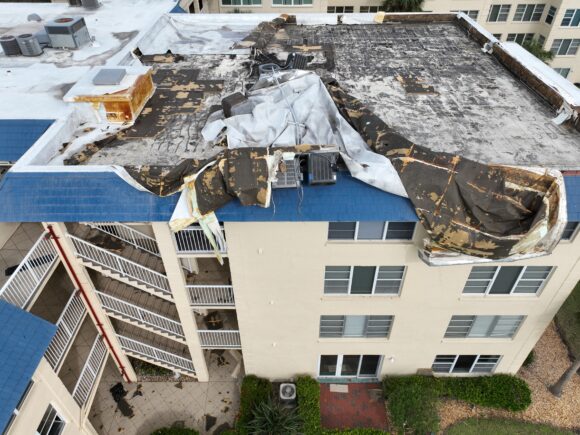After Hurricane Milton swept through parts of southwestern Florida in October, aerial drone images showed condominium buildings with large sections of their roof membranes peeled back like blankets on a beach, exposing the buildings to water intrusion.
Builders and commercial roof groups say there’s a better way, at least for some applications. It’s a liquid-applied material that won’t rip off, can last for decades and will help reduce insured losses in hurricanes, they say. But the product has run up against Florida insurance law and property insurers’ underwriting concerns. Now, one association has vowed to change the statute and the insurance industry’s alleged misconceptions.
The Roof Coating Manufacturers’ Association (RCMA) announced this month that it had hired a well-known Tallahassee lobbyist to bend the ears of lawmakers ahead of the Florida legislative session that begins March 6.
“These common-sense solutions will not only alleviate the financial burden on property owners but also reduce environmental waste and uphold the integrity of the roofing industry’s decades-long investment in durable, sustainable products,” Chip Case, a registered lobbyist and founder of Jefferson Monroe Consulting, said in a recent news release.
The association said in the statement that Florida regulations unfairly treat low-slope and steep-slope roofing as interchangeable. Mandates requiring the removal and replacement of roofs over 15 years old, regardless of their functionality, have led to skyrocketing costs for homeowners, the group argued.
It’s unclear exactly what regulations the RCMA is referring to. The association’s statement did not go into detail, and Case and the association did not return calls and emails from the Insurance Journal. But others in the roof industry have pointed to Florida statute 627.7011, which has given insurance carriers freedom to avoid writing residential properties with roofs that are older than 15 years, in many cases.
“An insurer may not refuse to issue or refuse to renew a homeowner’s policy insuring a residential structure with a roof that is less than 15 years old solely because of the age of the roof,” the statute reads. (Until that section of the law was approved in 2022, several Florida insurers, facing a growing number of fraudulent or exaggerated roof claims, along with claims litigation, had stopped writing some residential shingle roofs that were older than a mere 10 years.)
Another roofing group, the Florida Roofing & Sheetmetal Contractors Association, noted that the coating manufacturers may be overlooking the subsequent section of the 2022 law. That section can extend the insurability of a roof for at least another five years if an inspection shows the roof is in good condition.
“It’s really 15 years plus-plus,” said Mike Silvers, a roofing contractor and director of technical services for the roofing contractors’ association.
The coating issue has been around in one form or another for a few years. Some manufacturers have long touted roof coating products, applied over existing shingles, to extend the life of roofs. But insurance carriers aren’t convinced and most won’t write properties with older roofs, even with coatings.

“All the carriers I’ve talked to say that it does not extend the life of shingles,” said Mary Jordan, owner of Gulf Coast Insurance, an agency in Pensacola.
One West Palm Beach condo association recently spent millions of dollars coating its buildings’ roofs with a polyurethane and silicone product, only to find that its insurance company still refused to write the property – all because of the age of the roof, the Palm Beach Post reported this week.
Despite the apparent hesitance from insurers, new, liquid roof coverings have become increasingly popular for commercial buildings with low-slope or flat roofs – when applied to the roof decking, not on top of existing coverings. One product, manufactured by Sika Corp. and known as Sikalastic, for example, is a polyurethane compound that is rolled on. It comes with a 20-year warranty and is designed to bond directly with a concrete substrate, making it extremely resistant to wind uplift, according to builders and Sika Corp. information.
The product was recently installed as a replacement roof at a New Orleans hospital in Galliano, Louisiana, one of the most hurricane-prone parts of the country.
“It’s a good product,” Silvers said.
Some builders are hoping insurers in more states will embrace the value of liquid-applied roof systems and start offering premium discounts. The idea is similar to the credits insurers in many states now offer when homeowners install wind-resistant Fortified roofs and roof-to-wall connectors.
For now, though, credits for liquid roofs are hard to come by.
“There just aren’t that many breaks for commercial properties that I see,” said Keith Mercier, Florida West Coast President of CBIZ, an insurance brokerage that specializes in coverage for commercial and condo buildings.

Many Florida condominium associations, deep into the cost crisis brought on by the Surfside condo collapse in 2021, and by with new, statutorily mandated inspection costs, reserve funding requirements and by much higher insurance costs, are not clamoring for premium credits at this time.
“A lot of people are just happy to get coverage now,” Mercier said.
Florida lawmakers this spring may consider some changes to the condo reform law that was enacted in 2022 and delay some deadlines as condo owners face thousands of dollars in new costs. But that legislation is far from certain. It’s also uncertain if a 2024 law that established a pilot program for wind mitigation grants for condominiums will be funded again this year, according to news and industry reports.
It’s unclear how much traction the Roof Coating Manufacturers Association will have in its push to drop Florida’s 15-year rule on low-slope roofs. But the effort may, at the least, call attention to the problem created by any arbitrary time limit, Silvers said.
“Just drawing a line and saying anything older than that is too old is not really reasonable,” he said.
Such an approach discourages property owners from using superior materials, because they may figure that even if the roof covering has a lifetime warranty, they’ll have to get a new roof in 15 to 20 years, anyway.
“That makes selling longevity really, really hard,” Silvers said.
Top photo: A Longboat Key condo building with its roof membrane peeled back by Hurricane Milton’s winds. (Courtesy Matt Mercier)
Topics Florida
Was this article valuable?
Here are more articles you may enjoy.



 Trump Asserts Federal Government Power Over California Water
Trump Asserts Federal Government Power Over California Water  DeepSeek’s AI Restricted by ‘Hundreds’ of Companies in Days
DeepSeek’s AI Restricted by ‘Hundreds’ of Companies in Days  Progressive Net Income More Than Doubles in 2024
Progressive Net Income More Than Doubles in 2024  Growth of Pet Insurance Continues as Market Could Reach $4.5B
Growth of Pet Insurance Continues as Market Could Reach $4.5B 


